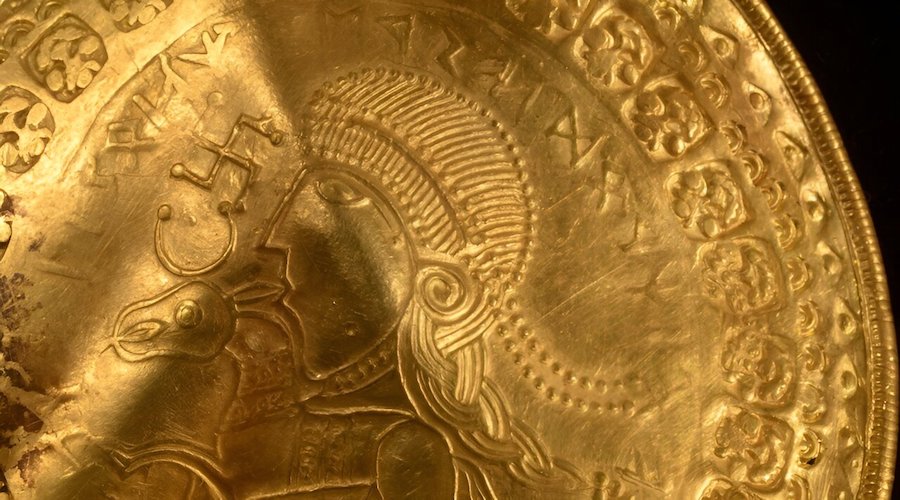
Researchers at the Technical University of Denmark (DTU) are employing cutting-edge technology to digitally unfold the world’s largest gold bracteate, which is a medallion-like necklace measuring 13.5cm.
The bracteate was found along with 15 other bracteates and four Roman medallions by an amateur archaeologist in 2021 in a field near the town of Vindelev in Denmark. Weighing 794 grams combined, the gold treasure is estimated to have been buried in the 6th century, and experts have compared the discovery to that of the Golden Horns of Gallehus.
The problem, however, is that many of the bracteates are folded to a point where the archaeologists cannot see the motifs and runic inscriptions on them. It is too risky to unfold the gold by hand, as it may break. This is where modern technology comes in.
“Sometimes technology can open doors that we can’t. In this case, we want to get a better look at the inscriptions and images on the bracteates so we can learn more about the nobleman who owned the treasure. What was his position? What was his domain? If we succeed, we will gain a better understanding of the structure of society in the 5th and 6th century,” Mads Ravn, archaeologist and head of research at the Vejle Museums, said in a media statement.
Ravn and his team used CT scanning to scan the artifacts. They ended up with 9,600 CT images that they have to unfold digitally.
One of the challenges in solving the mystery of the pieces was the varying thickness of the gold. Where the gold on the bracteates is thin due to stamp pressure and engravings, the scans have produced what are called CT artifacts, which are visual discrepancies between the real bracteate and the resulting CT image.
“In hospitals, artifacts occur when, for example, you’re performing a CT scan on a patient with surgical screws in their leg. The screws will create lines in the image, and the same thing has happened in this project. Our images are full of lines that wouldn’t be there if the bracteates had had the same thickness everywhere,” Carsten Gundlach, senior executive research officer at DTU Physics, said.
He used the data from the hundreds of 360-degree scans of each bracteate for calculations for the spatial 3D images. This method has resulted in fairly accurate 3D reconstructions of the bracteates in their folded condition. Nevertheless, the artifacts still caused trouble for Gundlach’s DTU Computer colleague, Hans Martin Kjer, who tried to unfold the bracteates digitally.
“We’ve tried to unfold one of the smaller bracteates called X17, but it’s difficult for us to define the edge of the bracteate and the exact line between two surfaces. When the gold has many tight folds, it makes it difficult for us to separate the surfaces from each other. Ultimately, it makes it very difficult to produce a perfect unfolding where you can see all the details,” Kjer said.
However, the two researchers refused to give up. Through conversations with the archaeologists, they have gained an idea of which motifs are of special interest in a historical context. The focus of the project has therefore shifted from unfolding the entire bracteate to unfolding the individual parts that can give archaeologists new knowledge about Denmark in the 5th and 6th centuries.
Ravn said that Denmark at the time of bracteates can best be described as what the Romans called “wild Germania.” It was a place where autocratic clan leaders ruled marked territories according to the same rules now used by biker gangs or the Mafia.
“The more wars they won, the stronger clan leaders they became. And the more gold and riches they could get for their followers, the more followers they got,” Ravn said.
Judging by the size of the treasure from Vindelev, he believes that its owner must have been a very powerful, but previously unknown, clan leader. This gives the site around Vindelev, located 8 kilometres east of Jelling, the cradle of Denmark, a new and significant status as a center of power.
At the same time, the treasure from Vindelev bears a close resemblance to other gold treasures found near the town of Gudme on Funen, which is considered to have been Denmark’s most important center of power from the 3rd to the 6th century. This leads archaeologists to believe that a blacksmith in Gudme may have made some of the bracteates from Vindelev. If that is the case, the gold must have changed owners at some point.
The theory is, therefore, that there was a close connection—perhaps an alliance—between the clan leaders of the two centers of power. “It’s possible that the gold was handed over as a gift in connection with weddings between daughters and sons from each clan,” Ravn said.
To confirm this theory, Ravn is particularly interested in seeing the motifs on the largest of the gold bracteates, which seems to have a folded twin motif in the middle. The stamps around the motif can also tell the researchers something about the origin of the bracteate and how old it is. If they turn out to bear the same stamps as the ones found in Gudme, then they were made by the same goldsmith, and the archaeologists can continue working with the theory of the close connection between Vindelev and Gudme.
“It’s a bit like a court case where the more circumstantial evidence we find, the stronger the case will be. We can’t exactly ask the witnesses who were there at the time. We rely on circumstantial evidence, and this is where DTU can help,” Ravn said.